African elephant
The African elephant (Loxodonta) is a genus comprising two living elephant species, the African bush elephant (L. africana) and the smaller African forest elephant (L. cyclotis). Both are herbivores and live in groups. They have grey skin and differ in the size of their ears and tusks, and in the shape and size of their skulls.
| African elephant | |
|---|---|
.jpg) | |
| African bush elephant bull in Ngorongoro Conservation Area | |
 | |
| African forest elephant cow with calf in Nouabalé-Ndoki National Park | |
| Scientific classification | |
| Kingdom: | Animalia |
| Phylum: | Chordata |
| Class: | Mammalia |
| Order: | Proboscidea |
| Family: | Elephantidae |
| Subfamily: | Elephantinae |
| Genus: | Loxodonta Anonymous, 1827[2] |
| Species | |
| |
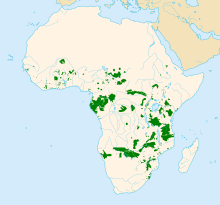 | |
| Distribution of living Loxodonta (2007) | |
Both species are listed as Vulnerable species on the IUCN Red List since 2004, and are threatened by habitat loss and fragmentation. Poaching for the illegal ivory trade is a threat in several range countries as well.
Loxodonta is one of two existing genera of the family Elephantidae. The name refers to the lozenge-shaped enamel of their molar teeth. Fossil remains of Loxodonta species have been excavated in Africa, dating to the Middle Pliocene.
Taxonomy


The first scientific description of the African elephant was written by Johann Friedrich Blumenbach in 1797 who proposed the scientific name Elephas africanus.[3] Loxodonte was proposed as generic name for the African elephant by Georges Cuvier in 1824. This name refers to the lozenge-shaped enamel of the molar teeth, which differs significantly from the shape of the Asian elephant's molar enamel.[4] An anonymous author used the Latinized spelling Loxodonta in 1827.[5] Anonymous was recognized as authority by the International Code of Zoological Nomenclature in 1999.[2]
Elephas (Loxodonta) cyclotis was proposed by Paul Matschie in 1900 who described three African elephant zoological specimens from Cameroon whose skulls differed in shape from elephant skulls collected elsewhere in Africa.[6] In 1936, Glover Morrill Allen considered this elephant to be a distinct species and called it 'forest elephant'.[7] Later authors considered it to be a subspecies.[8][9][1] Morphological and genetic analyses provided evidence for species-level differences between the African bush elephant and the African forest elephant.[10][11][12][13][14]
In 1907, Richard Lydekker proposed six African elephant subspecies based on the different sizes and shapes of their ears.[15] They are all considered synonymous with the African bush elephant.[2]
Extinct African elephants
Between the late 18th and 20th centuries, the following extinct African elephants were described on the basis of fossil remains:
- North African elephant (Loxodonta africana pharaohensis) proposed by Paulus Edward Pieris Deraniyagala in 1948 was a specimen from Fayum in Egypt.[16]
- Loxodonta atlantica was proposed as Elephas atlanticus by Auguste Pomel in 1879 based on a skull and bones found in Ternifine, Algeria.[17]
- Loxodonta exoptata proposed by Wilhelm Otto Dietrich in 1941 was based on teeth found in Laetoli, Tanzania.[18]
- Loxodonta adaurora proposed by Vincent Maglio in 1970 was a complete skeleton found in Kanapoi, Kenya.[19]
Phylogeny
Analysis of nuclear DNA sequences indicates that the genetic divergence between African bush and forest elephants dates 2.6 – 5.6 million years ago. The divergence between the Asian elephant and the woolly mammoths is estimated 2.5 – 5.4 million years ago, which strongly supports their status as distinct species. The African forest elephant was found to have a high degree of genetic diversity, perhaps reflecting periodic fragmentation of their habitat during the climatic changes in the Pleistocene.[13]
Gene flow between the two African elephant species was examined at 21 locations. The analysis revealed that several African bush elephants carried mitochondrial DNA of African forest elephants, which indicates that they hybridised in the savanna-forest transition zone also in ancient times.[20]
Sequence analysis of DNA from fossils of the extinct Eurasian Palaeoloxodon antiquus shows it to be much closer related to the African forest elephant than to the African bush elephant. The validity of Loxodonta has therefore been questioned.[21]
Description
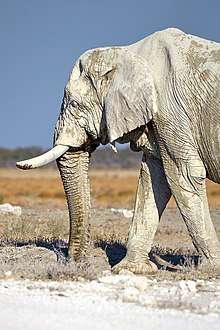
Skin, ears, and trunk

African elephants have a grey folded and up to 30 mm (1.2 in) thick skin that is covered with sparse bristled dark-brown to black hair. Short tactile hair grows on the trunk, which has two finger-like processes on the tip.[8] Their large ears help to reduce body heat; flapping them creates air currents and exposes the ears' inner sides where large blood vessels increase heat loss during hot weather. The trunk is a prehensile elongation of its upper lip and nose. This highly sensitive organ is innervated primarily by the trigeminal nerve, and thought to be manipulated by about 40–60,000 muscles. Because of this muscular structure, the trunk is so strong that elephants can use it for lifting about 3% of their own body weight. They use it for smelling, touching, feeding, drinking, dusting, producing sounds, loading, defending and attacking.[22] Elephants sometimes swim underwater and use their trunks as snorkels. [23]
Tusks and molars
Both male and female African elephants have tusks that grow from deciduous teeth called tushes, which are replaced by tusks when calves are about one year old. Tusks are composed of dentin, which forms small diamond-shaped structures in the tusk's center that become larger at its periphery.[22] Tusks are used for digging for roots and stripping the bark from trees for food, for fighting each other during mating season, and for defending themselves against predators. The tusks weigh from 23 to 45 kg (51–99 lb) and can be from 1.5 to 2.4 m (5–8 ft) long. They are curved forward and continue to grow throughout the elephant's lifetime.[24]
The dental formula of elephants is 1.0.3.30.0.3.3 × 2 = 26.[22] Elephants have four molars; each weighs about 5 kg (11 lb) and measures about 30 cm (12 in) long. As the front pair wears down and drops out in pieces, the back pair moves forward, and two new molars emerge in the back of the mouth. Elephants replace their teeth four to six times in their lifetimes. Around 40 to 60 years of age, the elephant loses the last of its molars and will likely die of starvation, a common cause of death. African elephants have 24 teeth in total, six on each quadrant of the jaw. The enamel plates of the molars are fewer in number than in Asian elephants.[25]
Size
The African bush elephant is the largest terrestrial animal. Cows are 2.2–2.6 m (7.2–8.5 ft) tall at the shoulder and weigh 2,160–3,232 kg (4,762–7,125 lb), while bulls are 3.2–4 m (10–13 ft) tall and weigh 4,700–6,048 kg (10,362–13,334 lb).[8] Its back is concave-shaped, while the back of the African forest elephant is nearly straight.[10] The largest recorded individual stood 3.96 metres (13.0 ft) at the shoulder, and is estimated to have weighed 10,400 kg (22,900 lb).[26][27] The tallest recorded individual stood 4.21 m (13.8 ft) at the shoulder and weighed 8,000 kg (18,000 lb).[28]
The African forest elephant is smaller with male shoulder heights of up to 2.5 metres (8.2 ft).[29] It is the third largest terrestrial animal. Their thickset bodies rest on stocky legs.[30]
Distribution and habitat
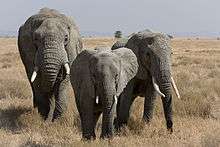
African elephants are distributed in Sub-Saharan Africa, where they inhabit Sahelian scrubland and arid regions, tropical rainforests, mopane and miombo woodlands. African forest elephants occur only in Central Africa.[31]
Behavior and ecology
Family
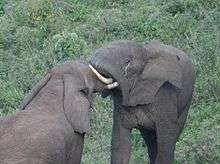
Both African elephant species live in family units comprising several adult cows, their daughters and their subadult sons. Each family unit is led by an older cow known as the matriarch.[32][33] African forest elephant groups are less cohesive than African bush elephant groups, probably because of the lack of predators.[33]
When separate family units bond, they form kinship or bond groups. After puberty, male elephants tend to form close alliances with other males. While females are the most active members of African elephant groups, both male and female elephants are capable of distinguishing between hundreds of different low frequency infrasonic calls to communicate with and identify each other.[34][35]
Elephants use some vocalisations that are beyond the hearing range of humans,[36] to communicate across large distances. Elephant mating rituals include the gentle entwining of trunks.[37]
Feeding
While feeding, the African elephant uses its trunk to pluck leaves and its tusk to tear at branches, which can cause enormous damage to foliage.[24] Fermentation of the food takes place in the hindgut, thus enabling large food intakes.[38]
Intelligence

African elephants are highly intelligent.[39] They have a very large and highly convoluted neocortex, a trait they share with humans, apes and some dolphin species. They are amongst the world's most intelligent species. With a mass of just over 5 kg (11 lb), the elephant brain is larger than that of any other terrestrial animal. The elephant's brain is similar to a human brain in terms of structure and complexity; the elephant's cortex has as many neurons as that of a human brain,[40] suggesting convergent evolution.[41]
Elephants exhibit a wide variety of behaviors, including those associated with grief, learning, mimicry, art, play, a sense of humor, altruism, use of tools, compassion, cooperation,[42] self-awareness, memory and possibly language.[43] All point to a highly intelligent species that is thought to be equal with cetaceans[44][45][46] and primates.[45][47]
Reproduction
African elephants are at their most fertile between the ages of 25 and 45. Calves are born after a gestation period of up to nearly two years.[30] The calves are cared for by their mother and other young females in the group, known as allomothering.[32]
African elephants show sexual dimorphism in weight and shoulder height by age 20, due to the rapid early growth of males. By age 25, males are double the weight of females; however, both sexes continue to grow throughout their lives.
Female African elephants are able to start reproducing at around 10 to 12 years of age,[48] and are in estrus for about 2 to 7 days. They do not mate at a specific time; however, they are less likely to reproduce in times of drought than when water is plentiful. The gestation period of an elephant is 22 months and fertile females usually give birth every 3–6 years, so if they live to around 50 years of age, they may produce 7 offspring. Females are a scarce and mobile resource for the males so there is intense competition to gain access to estrous females.
Post sexual maturity, males begin to experience musth, a physical and behavioral condition that is characterized by elevated testosterone, aggression and more sexual activity.[49][50] Musth also serves a purpose of calling attention to the females that they are of good quality, and it cannot be mimicked as certain calls or noises may be. Males sire few offspring in periods when they are not in musth. During the middle of estrus, female elephants look for males in musth to guard them. The females will yell, in a loud, low way to attract males from far away. Male elephants can also smell the hormones of a female ready for breeding. This leads males to compete with each other to mate, which results in the females mating with older, healthier males.[51] Females choose to a point who they mate with, since they are the ones who try to get males to compete to guard them. However, females are not guarded in the early and late stages of estrus, which may permit mating by younger males not in musth.
Males over the age of 25 compete strongly for females in estrous, and are more successful the larger and more aggressive they are.[52] Bigger males tend to sire bigger offspring.[53] Wild males begin breeding in their thirties when they are at a size and weight that is competitive with other adult males. Male reproductive success is maximal in mid-adulthood and then begins to decline. However, this can depend on the ranking of the male within their group, as higher-ranking males maintain a higher rate of reproduction.[54] Most observed matings are by males in musth over 35 years of age. Twenty-two long observations showed that age and musth are extremely important factors; "… older males had markedly elevated paternity success compared with younger males, suggesting the possibility of sexual selection for longevity in this species." (Hollister-Smith, et al. 287).
Males usually stay with a female and her herd for about a month before moving on in search of another mate. Less than a third of the population of female elephants will be in estrus at any given time and gestation period of an elephant is long, so it makes more evolutionary sense for a male to search for as many females as possible rather than stay with one group.
Threats
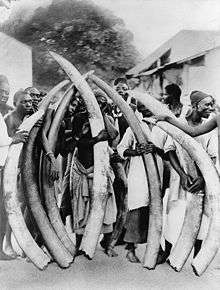
Based on vegetation types that provide suitable habitat for African elephants, it was estimated that in the early 19th century a maximum of 26,913,000 African elephants might have been present from the Sahel in the north to the Highveld in the south. Decrease of suitable habitat was the major cause for the decline of elephant populations until the 1950s. Hunting African elephants for the ivory trade accelerated the decline from the 1970s onwards. The carrying capacity of remaining suitable habitats was estimated at 8,985,000 elephants at most by 1987.[55] In the 1970s and 1980s, the price for ivory rose, and poaching for ivory increased in particular in Central African range countries where access to elephant habitats was facilitated by logging and petroleum mining industries.[31] Between 1976 and 1980, about 830 t (820 long tons; 910 short tons) raw ivory was exported from Africa to Hong Kong and Japan, equivalent to tusks of about 222,000 African elephants.[56]
The first continental elephant census was carried out in 1976. At the time, 1.34 million elephants were estimated to range over 7,300,000 km2 (2,800,000 sq mi).[57] In the 1980s, it was difficult to carry out systematic surveys in several East African range countries due to civil wars.[31] In 1987, it was estimated that the African elephant population had declined to 760,000 individuals. In 1989, only 608,000 African elephants were estimated to have survived.[57] In 1989, the Kenyan Wildlife Service burned a stockpile of tusks in protest against the ivory trade.[58] The population in the Tanzanian Selous Game Reserve, once the largest of any reserve in the world, dropped from 109,000 in 1976 to 13,000 in 2013.[59]
When the international ivory trade reopened in 2006, the demand and price for ivory increased in Asia. In Chad's Zakouma National Park, more than 3,200 elephants were killed between 2005 and 2010. The park did not have sufficient guards to combat poaching, and their weapons were outdated. Well organized networks facilitated smuggling the ivory through Sudan.[60] The government of Tanzania estimated that more than 85,000 elephants were lost to poaching in Tanzania between 2009 and 2014, representing a 60% loss.[61] By 2014 it was estimated that only 50,000 elephants remained in Central Africa. The last major populations are present in Gabon and the Republic of Congo.[59] In 2012, The New York Times reported a large upsurge in ivory poaching, with about 70% of the product flowing to China.[62]
Conflicts between elephants and a growing human population are a major issue in elephant conservation.[31] Human encroachment into natural areas where bush elephants occur or their increasing presence in adjacent areas has spurred research into methods of safely driving groups of elephants away from humans. Playback of the recorded sounds of angry honey bees has been found to be remarkably effective at prompting elephants to flee an area.[63]
According to the World Wide Fund for Nature, in 2014 the total population of African elephants was estimated to be around 700,000, and the Asian elephant population was estimated to be around 32,000. The population of African elephants in Southern Africa is large and expanding, with more than 300,000 within the region; Botswana has 200,000 and Zimbabwe 80,000. Large populations of elephants are confined to well-protected areas. However, conservative estimates were that 23,000 African elephants were killed by poachers in 2013[59] and less than 20% of the African elephant range was under formal protection.[64] The International Union for Conservation of Nature released a report in September 2016 that estimates Africa's elephant population at 415,000. They reported that in the past decade, this is a decline of 111,000 elephants. This is reported as the worst decline in the past 25 years.[65]
China was the biggest market for poached ivory but announced that it would phase out the legal domestic manufacture and sale of ivory products in May 2015, and in September of that year, China and the U.S.A. "said they would enact a nearly complete ban on the import and export of ivory."[66] In response Chinese consumers moved to purchasing their ivory through markets in Laos, leading conservation groups to request pressure be put on Laos to end the trade.[67]
Conservation
In 1986, the African Elephant Database was initiated with the aim to monitor the status of African elephant populations. This database includes results from aerial surveys, dung counts, interviews with local people and data on poaching.[68]
In 1989, the Convention on International Trade in Endangered Species of Wild Fauna and Flora listed the African elephant on CITES Appendix I. This listing banned international trade of African elephants and their body parts by countries that signed the CITES agreement. Hunting elephants is banned in the Central African Republic, Democratic Republic of Congo, Gabon, Côte d'Ivoire, and Senegal. After the ban came into force in 1990, retail sales of ivory carvings in South Africa have plummeted by more than 95% within 10 years.[69] As a result of the trade ban, African elephant populations recovered in Southern African range countries.[70]
The African Elephant Specialist Group has set up a Human-Elephant Conflict Task Force with the aim to develop conflict mitigation strategies.[71]
In 2005, the West African Elephant Memorandum of Understanding was signed by 12 West African countries. The Convention on the Conservation of Migratory Species of Wild Animals provided financial support for four years to implement the West African Elephant Conservation Strategy, which forms the central component of this intergovernmental treaty.[72]
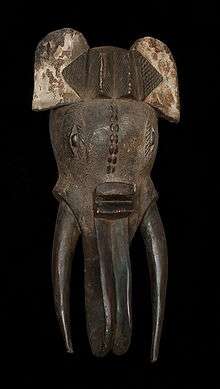
In 2019, the export of wild African elephants to zoos around the world was banned, with an exception added by the EU to allow export in "exceptional cases where … it is considered that a transfer to ex-situ locations will provide demonstrable in-situ conservation benefits for African elephants”. Previously, export had been allowed in Southern Africa with Zimbabwe capturing and exporting more than 100 baby elephants to Chinese zoos since 2012.[73]
In culture
Many African cultures revere the African Elephant as a symbol of strength and power.[74][75] It is also praised for its size, longevity, stamina, mental faculties, cooperative spirit, and loyalty.[76] The animal's religious importance is mostly totemic.[77] Many societies believed that their chiefs would be reincarnated as elephants. During the 10th century AD, the people of Igbo-Ukwu, near the Niger Delta, buried their leaders with elephant tusks.[78]
South Africa, uses elephant tusks in their coat of arms to represent wisdom, strength, moderation and eternity.[79] The elephant is symbolically important to the nation of Ivory Coast (Côte d'Ivoire); the Coat of arms of Ivory Coast features an elephant head escutcheon as its focal point.
In the western African Kingdom of Dahomey (now part of Benin) the elephant was associated with the 19th century rulers of the Fon people, Guezo and his son Glele.[lower-alpha 1] The animal is believed to evoke strength, royal legacy, and enduring memory as related by the proverbs: "There where the elephant passes in the forest, one knows" and "The animal steps on the ground, but the elephant steps down with strength."[80] Their flag depicted an elephant wearing a royal crown.
See also
Notes
- Guezo and Glele ruled from 1818 to 1858 and from 1858 to 1889, respectively
References
This article incorporates text from the ARKive fact-file "African elephant" under the Creative Commons Attribution-ShareAlike 3.0 Unported License and the GFDL.
- Blanc, J. (2008). "Loxodonta africana". IUCN Red List of Threatened Species. IUCN. 2008: e.T12392A3339343. doi:10.2305/IUCN.UK.2008.RLTS.T12392A3339343.en. Retrieved 8 June 2019.
- Shoshani, J. (2005). "Genus Loxodonta". In Wilson, D.E.; Reeder, D.M (eds.). Mammal Species of the World: A Taxonomic and Geographic Reference (3rd ed.). Johns Hopkins University Press. p. 91. ISBN 978-0-8018-8221-0. OCLC 62265494.
- Blumenbach, J. F. (1797). "2. Africanus". Handbuch der Naturgeschichte [Handbook of Natural History] (Fifth ed.). Göttingen: Johann Christian Dieterich. p. 125.
- Cuvier, G. (1824). "Éléphants d'Afrique". In Geoffroy-Saint-Hilaire, É.; Cuvier, F. (eds.). Histoire Naturelle des Mammifères, avec des figures originales, coloriées, dessinées d'après des animaux vivans. Tome 6. Paris: A. Belain. pp. 117–118.
- Anonymous (1827). "Analytical Notices of Books. Histoire Naturelle des Mammifères, avec des Figures originale, dessinées d'après des Animaux vivans; &c. Par MM. Geoffroy-Saint-Hilaire, et F. Cuvier. Livraison 52 et 53". The Zoological Journal. 3 (9): 140–143.
- Matschie, P. (1900). "Geographische Abarten des Afrikanischen Elefanten". Sitzungsberichte der Gesellschaft Naturforschender Freunde zu Berlin. 3: 189–197.
- Allen, G. M. (1936). "Zoological results of the George Vanderbilt African Expedition of 1934. Part II — The forest elephant of Africa". Proceedings of the Academy of Natural Sciences of Philadelphia. 88: 15–44. JSTOR 4064188.
- Laurson, B.; Bekoff, M. (1978). "Loxodonta africana" (PDF). Mammalian Species (92): 1–8. doi:10.2307/3503889. JSTOR 3503889. Retrieved 5 August 2010.
- Estes, R. D. (1999). "Elephant Loxodonta africana Family Elephantidae, Order Proboscidea". The Safari Companion: A Guide to Watching African Mammals Including Hoofed Mammals, Carnivores, and Primates (Revised and expanded ed.). Vermont: Chelsea Green Publishing Company. p. 223–233. ISBN 1-890132-44-6.
- Grubb, P.; Groves, C. P.; Dudley, J. P.; Shoshani, J. (2000). "Living African elephants belong to two species: Loxodonta africana (Blumenbach, 1797) and Loxodonta cyclotis (Matschie, 1900)". Elephant. 2 (4): 1–4. doi:10.22237/elephant/1521732169.
- Roca, A. L.; Georgiadis, N.; Pecon-Slattery, J.; O'Brien, S. J. (2001). "Genetic Evidence for Two Species of Elephant in Africa". Science. 293 (5534): 1473–1477. Bibcode:2001Sci...293.1473R. doi:10.1126/science.1059936. PMID 11520983.
- Rohland, N.; Malaspinas, A.-S.; Pollack, J. L.; Slatkin, M.; Matheus, P.; Hofreiter, M. (2007). "Proboscidean Mitogenomics: Chronology and Mode of Elephant Evolution Using Mastodon as Outgroup". PLOS Biology. 5 (8): e207. doi:10.1371/journal.pbio.0050207. PMC 1925134. PMID 17676977.
- Rohland, N.; Reich, D.; Mallick, S.; Meyer, M.; Green, R. E.; Georgiadis, N. J.; Roca, A. L.; Hofreiter, M. (2010). "Genomic DNA sequences from mastodon and woolly mammoth reveal deep speciation of forest and savanna elephants". PLOS Biology. 8 (12): e1000564. doi:10.1371/journal.pbio.1000564. PMC 3006346. PMID 21203580.
- Murphy, W. J.; Ishida, Y.; Oleksyk, T. K.; Georgiadis, N. J.; David, V. A.; Zhao, K.; Stephens, R. M.; Kolokotronis, S.-O.; Roca, A. L. (2011). "Reconciling Apparent Conflicts between Mitochondrial and Nuclear Phylogenies in African Elephants". PLOS ONE. 6 (6): e20642. Bibcode:2011PLoSO...620642I. doi:10.1371/journal.pone.0020642. PMC 3110795. PMID 21701575.
- Lydekker, R. (1907). "The Ears as a Race-Character in the African Elephant". Proceedings of the Zoological Society of London (January to April): 380–403.
- Deraniyagala, P. E. P. (1955). Some extinct elephants, their relatives, and the two living species. Colombo: Ceylon National Museums Publication.
- Pomel, A. (1897). "Elephas atlanticus Pom.". Les éléphants quaternaires. Paléontologie : monographies. Alger: P. Fontana & Co. pp. 42–59.
- Dietrich, W. O. (1941). "Die säugetierpaläontologischen Ergebnisse der Kohl-Larsen'schen Expedition 1937–1939 im nördlichen Deutsch-Ostafrika". Zentralblatt für Mineralogie, Geologie und Paläontologie. B (8): 217–223.
- Maglio, V. J. (1970). "Four new species of Elephantidae from the Plio-Pleistocene of northwestern Kenya". Breviora (341): 1–43.
- Roca, A. L.; Georgiadis, N.; O'Brien, S. J. (2004). "Cytonuclear genomic dissociation in African elephant species" (PDF). Nature Genetics. 37 (1): 96–100. doi:10.1038/ng1485. PMID 15592471.
- Meyer, M.; Palkopoulou, E.; Baleka, S.; Stiller, M.; Penkman, K. E.; Alt, K. W.; Ishida, Y.; Mania, D.; Mallick, S.; Meijer, T.; Meller, H. (2017). "Palaeogenomes of Eurasian straight-tusked elephants challenge the current view of elephant evolution". eLife. 6. doi:10.7554/eLife.25413. PMC 5461109. PMID 28585920.
- Shoshani, J. (1978). "General information on elephants with emphasis on tusks". Elephant. 1 (2): 20–31. doi:10.22237/elephant/1491234053.
- West, J.B. (April 2002). "Why doesn't the elephant have a pleural space?". News in Physiological Sciences. 17 (2): 47–50. doi:10.1152/nips.01374.2001. PMID 11909991.
- Burnie, D. (2001). Animal. London: Dorling Kindersley.
- Clutton-Brock, Juliet (1987). A Natural History of Domesticated Mammals. p. 208. ISBN 0-521-34697-5.
- Larramendi, A. (2016). "Shoulder height, body mass and shape of proboscideans" (PDF). Acta Palaeontologica Polonica. 61 (3): 537–574. doi:10.4202/app.00136.2014.
- Wood, G. (1983). The Guinness Book of Animal Facts and Feats. Enfield, Middlesex: Guinness Superlatives. p. . ISBN 978-0-85112-235-9.
- McFarlan, D.; McWhirter, N. (1992). "Mammals". The Guinness book of records, 1992. New York: Bantam Books.
- "Forest elephant videos, photos and facts – Loxodonta cyclotis". ARKive. 2 September 2006. Archived from the original on 24 October 2014. Retrieved 28 March 2014.
- Macdonald, D. (2001). The New Encyclopedia of Mammals. Oxford: Oxford University Press.
- Blanc, J. J.; Thouless, C. R.; Hart, J. A.; Dublin, H. T.; Douglas-Hamilton, I.; Craig, G. C.; Barnes, R. F. W. (2003). African Elephant Status Report 2002: An update from the African Elephant Database. Occasional Paper of the IUCN Species Survival Commission No. 29. Gland and Cambridge: IUCN. ISBN 9782831707075.
- Douglas-Hamilton, I. (1972). On the ecology and behaviour of the African elephant: the elephants of Lake Manyara (PhD thesis). Oxford: University of Oxford.
- Turkalo, A.; Barnes, R. (2013). "Loxodonta cyclotis Forest Elephant". In Kingdon, J.; Happold, D.; Hoffmann, M.; Butynski, T.; Happold, M.; Kalina, J. (eds.). The Mammals of Africa. Volume I. Introductory Chapters and Afrotheria. London: Bloomsbury Publishing. pp. 195–200.
- McComb, K.; Moss, C.; Sayialel, S.; Baker, L. (2000). "Unusually extensive networks of vocal recognition in African elephants". Animal Behaviour. 59 (6): 1103–1109. doi:10.1006/anbe.2000.1406. PMID 10877888.
- McComb, K.; Moss, C.; Durant, S. M.; Baker, L.; Sayialel, S. (2001). "Matriarchs As Repositories of Social Knowledge in African Elephants". Science. 292 (5516): 491–494. Bibcode:2001Sci...292..491M. doi:10.1126/science.1057895. PMID 11313492.
- Herbst, C. T.; Stoeger, A. S.; Frey, R.; Lohscheller, J.; Titze, I.; Gumpenberger, M.; Fitch, W. T. (2012). "How Low Can You Go? Physical Production Mechanism of Elephant Infrasonic Vocalizations". Science. 337 (6094): 595–599. Bibcode:2012Sci...337..595H. doi:10.1126/science.1219712. PMID 22859490.
- Buss, I.; Smith, N. (1966). Observations on Reproduction and Breeding Behavior of the African Elephant (PDF). Allen Press. Archived from the original (PDF) on 18 May 2015. Retrieved 8 March 2013.
- Clauss, M.; Frey, R.; Kiefer, B.; Lechner-Doll, M.; Loehlein, W.; Polster, C.; Roessner, G. E.; Streich, W. J. (2003). "The maximum attainable body size of herbivorous mammals: morphophysiological constraints on foregut, and adaptations of hindgut fermenters" (PDF). Oecologia. 136 (1): 14–27. Bibcode:2003Oecol.136...14C. doi:10.1007/s00442-003-1254-z. PMID 12712314.
- Plotnik, J. M.; De Waal, F. B.; Reiss, D. (2006). "Self-recognition in an Asian elephant". Proceedings of the National Academy of Sciences. 103 (45): 17053–17057. Bibcode:2006PNAS..10317053P. doi:10.1073/pnas.0608062103. PMC 1636577. PMID 17075063.
- Roth, G.; Stamenov, M. I.; Gallese, V. (2003). "Is the human brain unique?". Mirror Neurons and the Evolution of Brain and Language. John Benjamins Publishing. pp. 63–76. doi:10.1002/0470867221.ch2. ISBN 978-0-470-84960-6.
- Goodman, M.; Sterner, K.; Islam, M.; Uddin, M.; Sherwood, C.; Hof, P.; Hou, Z.; Lipovich, L.; Jia, H.; Grossman, L.; Wildman, D. (2009). "Phylogenomic analyses reveal convergent patterns of adaptive evolution in elephant and human ancestries". Proceedings of the National Academy of Sciences. 106 (49): 20824–20829. Bibcode:2009PNAS..10620824G. doi:10.1073/pnas.0911239106. PMC 2791620. PMID 19926857.
- Plotnik, J. M.; Suphachoksahakun, W.; Lair, R.; Plotnik, J. M. (2011). "Elephants know when they need assistance in a cooperative task". Proceedings of the National Academy of Sciences. 108 (12): 5116–5121. doi:10.1073/pnas.1101765108. PMC 3064331. PMID 21383191. Retrieved 8 March 2011.
- Parsell, D. L. (2003). "In Africa, Decoding the 'Language' of Elephants". National Geographic News. Archived from the original on 12 October 2007. Retrieved 30 October 2007.
- Viegas, Jennifer (2011). "Elephants smart as chimps, dolphins". ABC Science. Retrieved 8 March 2011.
- Viegas, Jennifer (2011). "Elephants Outwit Humans During Intelligence Test". Discovery News. Archived from the original on 8 March 2011. Retrieved 19 March 2011.
- "What Makes Dolphins So Smart?". The Ultimate Guide: Dolphins. 1999. Archived from the original on 14 May 2008. Retrieved 30 October 2007.
- Scott, D. (2007). "Elephants Really Don't Forget". Daily Express. Archived from the original on 12 March 2008. Retrieved 30 October 2007.
- Benedict, F. G. (1936). "The physiology of the elephant". Carnegie Inst. Washington Pub. No. 474. 1.
- Hollister-Smith, J. A.; Poole, J. H.; Archie, E. A.; Vance, E. A.; Georgiadis, N. J.; Moss, C. J.; Alberts, S. C. (2007). "Age, musth, and paternity success in wild male African elephants, Loxodonta africana" (PDF). Animal Behaviour. 74 (2): 287–296. doi:10.1016/j.anbehav.2006.12.008. Archived from the original (PDF) on 18 May 2015.
- Sukumar, R. (2003). The Living Elephants: Evolutionary Ecology, Behavior, and Conservation. New York: Oxford University Press, Inc. p. 112. ISBN 0-19-510778-0.
- Poole, Joyce H. (1989). "Mate guarding, reproductive success and female choice in African elephants". Animal Behaviour. 37: 842–849. doi:10.1016/0003-3472(89)90068-7.
- Sukumar, R. (2003). The Living Elephants: Evolutionary Ecology, Behavior, and Conservation. New York: Oxford University Press, Inc. pp. 112–124. ISBN 0-19-510778-0.
- Lee, Phyllis C.; Moss, Cynthia J. (1986). "Early maternal investment in male and female African elephant calves". Behavioral Ecology and Sociobiology. 18 (5): 353–361. doi:10.1007/bf00299666.
- Loizi, H.; Goodwin, T. E.; Rasmussen, L. E. L.; Whitehouse, A. M.; Schulte, B. A. (2009). "Sexual dimorphism in the performance of chemosensory investigatory behaviours by African elephants (Loxodonta africana)". Behaviour. 146 (3): 373–392. doi:10.1163/156853909X410964.
- Milner-Gulland, E. J.; Beddington, J. R. (1993). "The exploitation of elephants for the ivory trade: an historical perspective". Proceedings of the Royal Society B: Biological Sciences. 252 (1333): 29–37. Bibcode:1993RSPSB.252...29M. doi:10.1098/rspb.1993.0042.
- Parker, J. S. C.; Martin, E. B. (1982). "How many elephants are killed for the ivory trade?" (PDF). Oryx. 16 (3): 235–239. doi:10.1017/S0030605300017452.
- Stiles, D. (2004). "The ivory trade and elephant conservation" (PDF). Environmental Conservation. 31 (4): 309–321. doi:10.1017/S0376892904001614.
- Poole, J. (1996). Coming of Age With Elephants. New York: Hyperion. p. 232. ISBN 0-7868-6095-2.
- Vira, Varun and Ewing, Thomas (April 2014) Ivory's Curse Born Free USA and C4ADS. Retrieved 16 May 2014
- Poilecot, P. (2010). "Le braconnage et la population d'éléphants au Parc National de Zakouma (Tchad)". Bois et Forêts des Tropiques. 303 (303): 93–102. doi:10.19182/bft2010.303.a20454.
- Mathiesen, K. (2015). "Tanzania elephant population declined by 60% in five years, census reveals". The Guardian. London. Retrieved 23 August 2017.
- Gettleman, Jeffrey (3 September 2012). "Elephants Dying in Epic Frenzy as Ivory Fuels Wars and Profits". The New York Times.
- King, L. E.; Douglas-Hamilton, I.; Vollrath, F. (2007). "African elephants run from the sound of disturbed bees". Current Biology. 17 (19): R832–R833. doi:10.1016/j.cub.2007.07.038. PMID 17925207.
- "Endangered species" Panda.org website.
- "Poaching behind worst African elephant losses in 25 years". IUCN (23 September 2016).
- Fergus Ryan (26 September 2015). "China and US agree on ivory ban in bid to end illegal trade globally". the Guardian.
- Kairu, Pauline (2 October 2017). "Elephants still at risk with Laos replacing China as ivory market". Daily Nation. Nairobi. Retrieved 3 October 2017.
- Thouless, C. R.; Dublin, H. T.; Blanc, J. J.; Skinner, D. P.; Daniel, T. E.; Taylor, R. D.; Maisels, F.; Frederick, H. L.; Bouché, P. (2016). African Elephant Status Report 2016 : an update from the African Elephant Database (PDF). Occasional Paper of the IUCN Species Survival Commission No. 60. Gland: IUCN SSC African Elephant Specialist Group. ISBN 978-2-8317-1813-2.
- Stiles, D.; Martin, E. (2001). "Status and trends of the ivory trade in Africa, 1989–1999" (PDF). Pachyderm (30): 24–36.
- Blanc, J. J.; Barnes, R. F. W.; Craig, G. C.; Dublin, H. T.; Thouless, C. R.; Douglas-Hamilton, I.; Hart, J. A. (2007). African Elephant Status Report 2007: An update from the African Elephant Database (PDF). Occasional Paper of the IUCN Species Survival Commission No. 33. Gland: IUCN SSC African Elephant Specialist Group.
- Naughton, L.; Rose, R.; Treves, A. (1999). The social dimensions of human-elephant conflict in Africa: A literature review and case studies from Uganda and Cameroon. Madison: University of Wisconsin.
- Dublin, H. (2005). "African Elephant Specialist Group report". Pachyderm (39): 1–9.
- "Near-total ban imposed on sending wild African elephants to zoos".
- "383. African Elephant (Loxodonta africana)". EDGE: Mammal Species Information. Retrieved 7 December 2012.
- "West African Elephants". Convention on Migratory Species. Retrieved 7 December 2012.
- "Elephant: The Animal and Its Ivory in African Culture". Fowler Museum at UCLA. Archived from the original on 30 March 2013. Retrieved 24 January 2013.
- Sukumar, R. (11 September 2003). The Living Elephants: Evolutionary Ecology, Behaviour, and Conservation. Oxford University Press, USA. p. 87. ISBN 978-0-19-510778-4. OCLC 935260783.
- Wylie, D. (15 January 2009). Elephant. Reaktion Books. p. 79. ISBN 978-1-86189-615-5. OCLC 740873839.
- "National Coat of Arms". South African Government Information. Archived from the original on 4 September 2012. Retrieved 7 December 2012.
- "Elephant Figure | Fon peoples | The Met". The Metropolitan Museum of Art. Retrieved 12 December 2017.
External links
| Wikimedia Commons has media related to Loxodonta. |
- CMS West African Elephant Memorandum of Understanding
- Elephant Information Repository – An in-depth resource on elephants
- "Elephant caves" of Mt Elgon National Park
- ElephantVoices – Resource on elephant vocal communications
- Amboseli Trust for Elephants – Interactive web site
- Another Elephant – A hub for saving the elephants.
- David Quammen: " Family ties – The elephants of Samburu" National Geographic magazine, September 2008 link
- EIA 25 yrs investigating the ivory trade, reports etc
- EIA (in the USA) reports etc
- International Elephant Foundation
